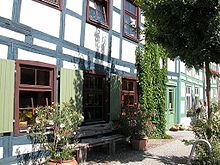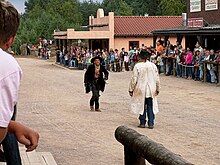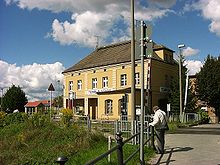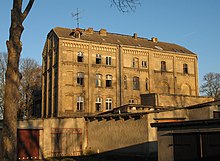Templin
| coat of arms | Germany map | |
|---|---|---|
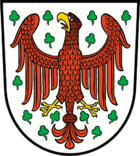
|
Coordinates: 53 ° 7 ' N , 13 ° 30' E |
|
| Basic data | ||
| State : | Brandenburg | |
| County : | Uckermark | |
| Height : | 60 m above sea level NHN | |
| Area : | 379.5 km 2 | |
| Residents: | 15,728 (Dec. 31, 2019) | |
| Population density : | 41 inhabitants per km 2 | |
| Postal code : | 17268 | |
| Primaries : | 03987, 039882, 039883, 039885 | |
| License plate : | UM, ANG, PZ, SDT, TP | |
| Community key : | 12 0 73 572 | |
| LOCODE : | DE TEM | |
| City structure: | 15 districts | |
City administration address : |
Prenzlauer Allee 7 17268 Templin |
|
| Website : | ||
| Mayor : | Detlef Tabbert ( The Left ) | |
| Location of the city of Templin in the Uckermark district | ||
Templin [tɛmˈpliːn] is the city with the largest area in the Uckermark district in the north of Brandenburg . Despite its only 16,000 inhabitants, it is the eighth largest city in Germany in terms of area .
geography
Templin is located in the natural area of the Templiner Platte . The Schorfheide forest area extends to the south .
City structure
According to its main statute, the city of Templin is divided into the following districts and inhabited districts in addition to the core city of Templin:
- Ahrensdorf
- bag
- Densow with the inhabited parts of the municipality Annenwalde , Neu Placht , Alt Placht
- Gandenitz
- Gollin with the inhabited part of the municipality Reiersdorf
- Groß Dölln with the inhabited parts of the municipality Bebersee , Groß Väter , Klein Väter and Klein Dölln
- Grunewald
- Hammelspring with the inhabited part of the municipality Alsenhof
- Herzfelde
- Hindenburg
- Klosterwalde with the inhabited part of the municipality Metzelthin
- Petznick with the inhabited part of the municipality Kreuzkrug
- Röddelin
- Storkow
- Vietmannsdorf with the inhabited part of the community Dargersdorf .
The following residential areas also exist in the area of the city of Templin: Albertshof, Albrechtsthal, Annenhof, Bandelowshof, Baßdorf, Birkenhof, Christianshof, Döllnkrug, Dollshof, Dorettenhof , Drei Häuser, Dusterlake, Eselshütte, Etashof, Fährkrug, Fennluch, Försterei, Forsthaus Buchheide, Forsthaus Krams, Forsthaus Laatz, Forsthaus Ringofen, Gleuenhof, Gut Gollin, Heckenhaus Hoheheide, Heinrichshof, Henkinshain, Hohenfelde, Joachimshof, Kannenburger Schleuse, Karlshof, Kienheide, Klosterwalder Mühle, Knehden, Kuckucksheim, Küstrinchener Weg, Lindenhof, Ludwigshof, Morgenland, Moritzhof, Moses Krug, Netzow, Papenwieser Weg, Paulinenhof, Postheim , Reinfeld, Rieckshof, Schleuse Schorfheide, Schmidtshof, Schulenburgslust, Schulzenfelde, Steindamm, Steinfeld, Stempnitz, Sydowshof, gatekeeper houses, Vorwerk Annenwalde "Waldhus", Waldhaus, Waldhof, Weiler, Werderhof, Wucker and To the Seehof .
history
Until the 19th century
For the origin of the name “Templin”, the Germanic word “timpen”, “tempen” or “tempel” with the meaning of “pointed hill” is being considered, which means contact between Germanic (up to the 5th century) and Slavic settlers (from the 6th century) . Century). (Cf. Vom Fischer and his wife , a fairy tale that the Brothers Grimm collected from a spring near Templin: Mantje, Mantje, timpete , for example 'Mondchen, Mondchen, zippfelt', i.e. the crescent moon.) Another possible source is the Slavic word "tąpy" or "topy" meaning "blunt". In addition, the derivation from a personal name "Tąp-l-" comes into consideration.
The city was first mentioned in 1270 as "Templyn". In the document of October 2, 1270, the exchange of countries between the Ascanian margraves and the bishop Heinrich of Brandenburg was sealed. A document, first issued in Templin in 1287, indicates a visit by Margrave Otto IV . A document dated August 30, 1314 named Templin “ city ” for the first time ( Oppidum Templin - oppidum Latin: “city, small town”).
On November 25, 1317 the " Peace of Templin " was concluded after the Margrave War between a coalition of North German princes and the Margraviate of Brandenburg .
In 1320 a pastor was named for the first time as "master Conrad" von Templin in a document. In 1397 they joined the city alliance with Stralsund, Stettin, Pasewalk, Prenzlau and Strasburg in order to counteract the widespread gang system. In the "Peace of Prenzlau" in 1479 Templin finally came to Brandenburg. For the first time in the history of Templin, there was evidence of a fire in 1492. In 1504 the city became the seat of a provost's office ; Even after the Reformation in 1539, Templin is the seat of a parish, and the superintendent now includes 24 parishes.
Parts of today's urban area were owned by the Himmelpfort monastery in the Middle Ages . Storkow belonged to the monastery since 1335. Krams was partially owned by the monastery from 1441 and completely from 1443 and later fell into desolation .
In 1574 there was a flood disaster. After a dam breach on Dolgensee , a two-meter high tidal wave poured out towards the city. In 1618, a large city fire destroyed large parts of the city. Five people, 309 houses, a church, town hall and school were victims of the flames. In 1622 an electoral privilege for a horse market was granted. 47 families fell victim to a plague epidemic in 1626. In 1627 the Thirty Years War reached the city, Danish troops besieged and blackmailed the city, only two thirds of which was rebuilt after the fire of 1618. The year 1637 was the worst year of the Thirty Years' War for the city and the entire Uckermark . In 1643 there were still 30 families living in the city; before the war there were 413.
The largest and last city fire in the city's history broke out in 1735. Only the St. George Chapel, the city wall, three city gates and a few houses survived this catastrophe. As a result, the first fire extinguishing regulations were issued in 1738: every citizen of the city had to have a wooden fire engine and a leather fire bucket in the house.
From May to October 2004, archaeological investigations were carried out in Kantstrasse in the course of the laying of supply lines. Along the Maria-Magdalenen-Kirche the old city cemetery was recorded over a length of about 90 m in a 1.5 m wide route. The church square served as the city cemetery from the first half of the 13th century. This was closed after the great fire in 1735. During the excavation work, 254 graves were recorded, which contained 276 skeletons due to several multiple burials. The graves lay in 3 to 4 layers on top of each other. Numerous stray bones and disturbed graves are evidence of the intensive use of the cemetery. The skeletons were examined by the anthropologist Bettina Jungklaus . Coffins were used in 56% of burials. The rest of the deceased were wrapped in a shroud and laid to rest. Some graves were multiple burials with up to three individuals. In one case, two older women were lying in a grave with a 2 to 3 year old boy who was buried in a prone position. In each of four graves there was a woman and a small child, which could be the mother with her child. A special find was a woman who died heavily pregnant and presumably died during childbirth because the child was breeched.
The Maria Magdalenen Church was reopened in 1749 and the town hall in 1751. In 1809 the streets within the city walls were divided into four districts: Königs-, Prenzlauer-, Berliner- and Mühlen-District. On April 1, 1848, the first printed newspaper appeared, the Templiner Kreisblatt - a non-profit entertainment paper for town and country . The volunteer fire brigade was founded on June 26, 1883.
At the end of the 19th century, industrialization brought decisive changes for Templin. On May 1, 1888, the Löwenberg – Templin railway was opened. In the following years it was carried on to Prenzlau , and the Britz – Fürstenberg railway was added. The water tower was built in 1898.
20th and 21st centuries
On October 1, 1901, the city was connected to the public telephone network. In 1912 the Joachimsthal Gymnasium moved from Berlin to Templin. A year later, the Prussian State Railways opened another line to Fürstenwerder .
In 1928 the synagogue at Berliner Straße 9 was rented to the Seventh-day Adventists by the smaller Jewish community . Regardless of this, she was set on fire by SA men on the night of the pogrom in 1938. A memorial plaque attached to the front building in 1988 is no longer there. The Jewish cemetery on Bahnhofstrasse in front of the Berliner Tor was also destroyed in 1938 . During World War II, an Anglo-American bombing raid on March 6, 1944 that killed 300 people, and fires at the end of the war destroyed 60% of the city center, including several blocks of timber-framed buildings and streets northwest of the market and the hospital. One third of the town hall was destroyed. In order to be able to bury the victims, another cemetery, the forest cemetery , was built. The railway line to Fürstenwerder was dismantled after the end of the war and delivered to the Soviet Union as reparations .
On March 31, 1957, the local history museum was opened in Prenzlauer Tor. On June 19, 1958, a summer camp called “ Klim Voroshilov ” of the Central Pioneer Organization was opened on the site on which the Jungspartakusbund had already operated a camp in 1928. Two years later the first massive buildings (such as kitchen, infirmary, etc.) followed and from 1975 the first permanent bungalows. In the summer months it was used as a pioneer camp and in winter as a training and education center for civil defense by universities.
In 1984 the Friedrich Engels FDGB Recreation Home was opened in the Postheim district . As the AHORN Seehotel Templin, it is now the largest hotel in Brandenburg.
In 1985 the city was awarded the title of " State Recognized Resort ", and in 1994 the award was renewed. In 1989 the Lehmann Garden (botanical garden from 1912 at the former Joachimsthal Gymnasium ) was reopened. The Uckermark Rehabilitation Clinic was built in 1995 and closed in 2006 due to bankruptcy. In 2000 the natural thermal bath Templin (the warmth of the water is natural, the grotto is artificial) was put into operation and reopened on December 22nd, 2006 after eight months of renovation.
On March 25, 2006 an ICE train from Deutsche Bahn was named Templin .
The Church of the Flying Spaghetti Monster Berlin-Brandenburg was founded as a registered association in Templin in 2006. Later the association opened nationwide and became the Church of the Flying Spaghetti Monster Germany e. V. The association was recognized as a non-profit body in 2012 because of the promotion of religious purposes. The last time he made a name for himself was in November 2014 when he set up signs at the entrance to Templin, indicating the day and time of the weekly pasta fair.
Administrative history
In March 1816, the Templin district was newly formed from parts of the Uckermark, the Ruppin District and the Glien-Löwenberg District , and on April 1, 1817 Templin became a district town. It was in the Prussian province of Brandenburg until 1947, and in the state of Brandenburg from 1947–1952 . 1952–1990 the Templin district belonged to the GDR district of Neubrandenburg , then again to the state of Brandenburg. Since the district reform in 1993 Templin has belonged to the Uckermark district .
Incorporations
On January 1, 1957, Ahrensdorf was incorporated. On October 1, 1961, however, the place was reclassified to Milmersdorf . With effect from July 1, 1993 the final assignment to Templin took place.
On October 26, 2003, Beutel, Densow, Gandenitz, Gollin, Groß Dölln, Grunewald, Hammelspring, Herzfelde, Klosterwalde, Petznick, Röddelin, Storkow and Vietmannsdorf were incorporated. The Templin-Land office was dissolved.
Population development
|
|
|
|
|
Territory of the respective year, number of inhabitants: as of December 31 (from 1991), from 2011 based on the 2011 census
The strong population growth in 2003 is due to the incorporation of 13 formerly independent municipalities.
politics
City Council
The city council of Templin consists of 28 members and the full-time mayor with the following distribution of seats:
| Party / group of voters | Seats |
|---|---|
| SPD | 5 |
| CDU | 5 |
| AfD | 5 |
| The left | 4th |
| Uckermärker Heide voter group | 3 |
| Alliance 90 / The Greens | 3 |
| Community of voters committed to the citizens | 2 |
| FDP | 1 |
(As of: local election on May 26, 2019 )
mayor
- 1990 to 2010: Ulrich Schoeneich (SPD, from 2005 independent)
- since 2010: Detlef Tabbert (Die Linke)
In the runoff election on March 14, 2010, Tabbert was elected mayor with 63.4% of the valid votes. In the mayoral election on January 14, 2018, he was confirmed in office for another eight years with 61.1% of the valid votes.
coat of arms
Blazon : "In silver, sprinkled with 14 green clover leaves , a gold-armored red eagle."
Historically, the city led the Brandenburg red eagle on a silver field without the shamrocks, but with a golden clover stem . It is also contained in this form in the important coat of arms collection of Johann Siebmacher . The shamrocks did not appear on the coat of arms until 1936. In the meantime it was " lily leaves ".
Town twinning
- Bad Lippspringe in North Rhine-Westphalia since 1990
- Połczyn-Zdrój (German: Bad Polzin ) in Poland since 1997
Sights and culture
Berliner Tor with Berliner Strasse
City wall at the Akzisehaus
- St. Maria Magdalenen Church (three-aisled baroque hall construction , 18th century)
- St. George Chapel
- Old town with a baroque town hall and half-timbered houses
- completely preserved city wall 1735 meters long and up to seven meters high with towers, city gates and 50 Wiek houses ; including the Berliner Tor , the Prenzlauer Tor , the Mühlentor and the Powder Tower
- Joachimsthalsches Gymnasium with Lehmann Garden (from 1912 until its final dissolution in 1953; the building on the Stadtsee is still there)
- Half-timbered church Kirchlein im Grünen in Alt Placht (Templin-Densow), built around 1700 as a manor chapel, restored from 1993, a. a. funded by the German Foundation for Monument Protection and the German Federal Environment Foundation
- Village church Annenwalde (Templin-Densow), built in 1833 by building inspector Hermann from Zehdenick based on the model of Schinkel's normal church, the plans being revised by Karl Friedrich Schinkel .
- Memorial stone from 1946/47 at the end of the village street in the Groß Väter district for the victims of fascism , redesigned from a relic of Göring's Carinhall country house
- VVN memorial from 1961 for anti-fascist resistance fighters in Templin Bahnhofstrasse
- Memorial stone on the hill behind the department store for the needy on Bahnhofstrasse in memory of the destroyed Jewish cemetery in Templin
- Thälmann memorial on Prenzlauer Allee in front of the Stadtbad in memory of the KPD chairman who was murdered in the Buchenwald concentration camp
- Templin / Groß Dölln airfield
- Natural thermal bath Templin
- Lindenhof stud
- Draisine route Templin – Fürstenberg
- El Dorado Templin
- Boat trips on Templin waters
- Excise House
- Alte Mühle Templin , former water mill
The place has been the seat of the religion-critical association The Church of the Flying Spaghetti Monster eV , which has been recognized in Germany as a belief community since the founding year 2012 .
Economy and Infrastructure
traffic
The federal road 109 between Zehdenick and Prenzlau and the state road 23 between Lychen and Joachimsthal run through the village . The federal motorway 11 (Berlin– Stettin ) runs around 25 km to the east , the nearest junctions are Pfingstberg and Joachimsthal .
The Templin Stadt and Templin train stations as well as the Hammelspring stop on the Templin – Löwenberg railway line are within the city limits. The route is served hourly by the regional train line RB 12 (Templin - Zehdenick - Löwenberg - Oranienburg - Berlin-Ostkreuz ) by the NEB operating company with class 643 railcars ( Bombardier Talent ). In 2012, both stations were modernized, and the renovated house platforms have been accessible since then .
Templin was once the crossing point of the Löwenberg (Mark) –Prenzlau and Fürstenberg / Havel – Eberswalde railway lines . In 1996 the railway line to Fürstenberg / Havel was closed for rail traffic. The track is now used as a tourist trolley line . In 2000, passenger traffic on the Templin – Prenzlau line was discontinued , and in 2006 on the Templin – Joachimsthal line . From December 2018, Templin received a direct rail connection to Joachimsthal and Eberswalde with the regional train line RB 63.
Several bus lines serve local public transport . From 1998 to 2002 the use of local public transport was free of charge . Since 2003, with an annual spa card, which costs € 44 in 2018, the buses within Templin can be used without an additional ticket.
education
From 1906 to 1943 there was a forestry school in Templin, where prospective foresters were trained.
Sports
With a total of eleven teams, SC Victoria 1914 Templin e. V. participates in games at state level (Brandenburg) and district level (Westuckermark football district).
The MSC Templin annually organizes motocross events at regional (state championships Berlin / Brandenburg) and nationwide (German championships). The motocross route "Im Kieferngrund" is located between the districts of Knehden and Klosterwalde.
On October 6, 1979, the first competition in women's football in the GDR took place in the Templin Stadium of Friendship in front of 3,100 spectators .
Personalities
Honorary citizen
- Richard Kirstein (1844–1926), pastor and deacon in Templin from 1890 to 1915, honorary citizen since 1916
- Hermann Wentzel (1856–1932), businessman and councilor in Templin, honorary citizen since August 1, 1924
- Erna Taege-Röhnisch (1909–1998), dialect writer, honorary citizen since 1993
- Angela Merkel (* 1954), politician, honorary citizen since June 27, 2018
sons and daughters of the town
- Prokop von Templin (1609–1680), writer and poet of sacred songs
- Martin Heinrich Fuhrmann (1669–1745), cantor and music theorist
- Joachim Heinrich Rühl (1730–1798), secret secretary and cashier of the General Domain Treasury in Berlin
- Elisabeth Halden (1841–1916), children's book author
- Kurt Graßhoff (1869–1952), naval officer, rear admiral in the First World War
- Wilhelm Wilcke (1885–1979), local painter
- Hermann Neef (1904–1950), politician (NSDAP), Reichsbeamtenführer
- Werner Pusch (1913–1988), politician (SPD), 1953–1961 member of the Bundestag
- Hanna Walz (1918–1997), politician (CDU), 1969–1980 member of the Bundestag
- Dorothea Binz (1920–1947), supervisor in the Ravensbrück concentration camp, born in Düsterlake
- Jan-Peters Janssen (1937-2017), sports psychologist
- Holde-Barbara Ulrich (* 1940), journalist and author
- Jorge Stever (1940–2019), painter and object artist
- Margit Bendokat (* 1943), actress
- Angela Winkler (* 1944), actress
- Manfred Kokot (* 1948), athlete, Olympic medal winner
- Roland Seidler (* 1951), actor
- Karl-Heinz Krüger (* 1953), boxer
- Conny Sauermann (* 1965), table tennis player
- Christa Wiese (* 1967), track and field athlete
- Wolfram Köhler (* 1968), politician (CDU), Lord Mayor of Riesa
- Jan-Ulrich Weiß (* 1975), politician (AfD)
Personalities associated with Templin
- Friederike Krüger (1789–1848), fighter in the Wars of Liberation
- Robert Eitner (1832–1905), musicologist
- Gustav Lehmann (1853–1928), educator and botanist
- Minna Ostrowski (1897–1967), resistance fighter against National Socialism
- Erna Taege-Röhnisch (1909–1998), dialect writer
- Horst Kasner (1926–2011), Protestant theologian, head of the Templin Pastoral College, father of Chancellor Angela Merkel
- Heinz Jankofsky (1935–2002), caricaturist
- Klaus-Jürgen Gundlach (* 1948), church musician and musicologist
- Rüdiger Weida (* 1951), Brother Spaghettus of the Church of the Flying Spaghetti Monster , satirist and performance artist
- Angela Merkel (* 1954), Federal Chancellor, grew up in Templin
literature
- Peter Feist: Medieval city view - Templin. Kai Homilius Verlag , Berlin 1995, ISBN 3-931121-09-7 .
- Lieselott Enders : Historical local dictionary for Brandenburg, Part VIII, Uckermark. Weimar 1986, ISBN 3-7400-0042-2 .
Web links
- Official website of the city of Templin
- Netzow in the RBB program Landschleicher on July 22, 2018
- Röddelin in the RBB program Landschleicher on July 17, 2016
Individual evidence
- ↑ Population in the State of Brandenburg according to municipalities, offices and municipalities not subject to official registration on December 31, 2019 (XLSX file; 223 KB) (updated official population figures) ( help on this ).
- ↑ Main statutes of the city of Templin from December 16, 2009 PDF
- ^ Service portal of the Brandenburg State Administration - City of Templin
- ^ Ernst Eichler and Hans Walther : City name book of the GDR . VEB Bibliographisches Institut, Leipzig 1988, ISBN 3-323-00007-2
- ^ Project Templin, St. Maria Magdalenen Church. In: anthropologie-jungklaus.de. Retrieved June 4, 2017 .
- ↑ Bettina Jungklaus : The medieval to early modern cemetery of the St. Maria Magdalenen Church, Templin . In: Templiner Heimatklub (Ed.): Templiner Heimatkalender 2007 . Schibri Verlag, 2006, ISBN 3-937895-39-6 , p. 100-102 .
- ↑ Götz Eckardt (ed.): Fates of German architectural monuments in the Second World War. A documentation of the damage and total losses in the area of the German Democratic Republic. Henschelverlag Art and Society, Berlin 1980, p. 134.
- ^ Notice of exemption from the Angermünde tax office
- ↑ Märkische Onlinezeitung, article from January 15, 2015 , accessed on March 19, 2015.
- ↑ Federal Statistical Office (Ed.): Municipalities 1994 and their changes since 01.01.1948 in the new federal states . Metzler-Poeschel, Stuttgart 1995, ISBN 3-8246-0321-7 .
- ^ StBA: Changes in the municipalities in Germany, see 2003
- ↑ Historical municipality register of the state of Brandenburg 1875 to 2005. District Uckermark . Pp. 30-33
- ↑ Population in the state of Brandenburg from 1991 to 2017 according to independent cities, districts and municipalities , Table 7
- ^ Office for Statistics Berlin-Brandenburg (Ed.): Statistical report AI 7, A II 3, A III 3. Population development and population status in the state of Brandenburg (respective editions of the month of December)
- ↑ Result of the local elections in 2019
- ^ Portrait of Ulrich Schoeneich. In: Der Tagesspiegel , August 16, 2008
- ^ Result of the mayoral election on January 14, 2018
- ↑ Coat of arms information on the service portal of the state administration of Brandenburg
- ↑ See Ancestry.com. Siebmacher's Wappenbuch [database on-line]. Provo, UT, USA: Ancestry.com Operations Inc, 2008. Original data: J. Siebmacher's large and general book of arms. Nuremberg: Bauer & Raspe, 1854–1961.
- ↑ With the steamer over five lakes . In: Der Tagesspiegel , June 4, 2006
- ↑ Notice of exemption from the Angermünde tax office ( memento of the original dated August 6, 2016 in the Internet Archive ) Info: The archive link has been inserted automatically and has not yet been checked. Please check the original and archive link according to the instructions and then remove this notice.
- ↑ Templin train stations with new house platforms. Deutsche Bahn AG, May 8, 2012, accessed on November 23, 2015 .
- ↑ https://www.moz.de/landkreise/oberhavel/gransee/gransee-artikel/dg/0/1/1692030/
- ↑ Tourist card. (No longer available online.) TMT Tourismus-Marketing Templin GmbH, archived from the original on April 21, 2018 ; accessed on April 20, 2018 . Info: The archive link was inserted automatically and has not yet been checked. Please check the original and archive link according to the instructions and then remove this notice.
- ↑ Bruno Oelmann: My most beautiful hiking trip. Chronicle of the Haardwald . Verlag Rudolf Winkelmann, Recklinghausen 2000, ISBN 3-921052-75-0 , p. 117.
- ^ Letter of honorary citizenship in the Museum of City History Templin
- ↑ City representatives decide: Angela Merkel becomes an honorary citizen of Templin | Nordkurier.de . June 27, 2018 ( nordkurier.de [accessed June 29, 2018]).




